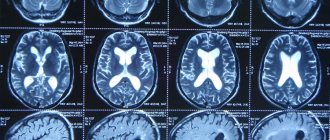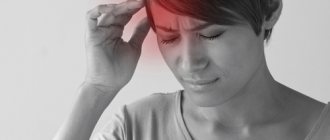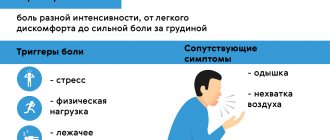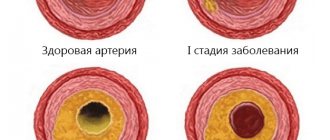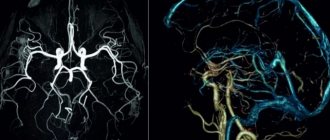JSC "Medicine" (clinic of academician Roitberg) operates a Pain Treatment Center. More details about the Pain Treatment Center
Pain Treatment Center, Neurologist
Alekseeva
Oksana Alexandrovna
22 years of experience
Doctor, highest qualification category, member of the European Association of Neurologists, Russian Interregional Society for the Study of Pain (ROIB), Association of Interdisciplinary Medicine. Has experience working in hospital and outpatient services. He has seven published works on neurology.
Make an appointment
A headache is one of the most unpleasant sensations a person can experience. Severe discomfort in the forehead, temples, crown or back of the head can indicate a variety of reasons, ranging from simple overwork and lack of adequate sleep to serious ailments that require immediate treatment.
Pain in the head can be throbbing, aching, pressing, cutting, squeezing. Its nature, degree of intensity, as well as localization often make it possible to determine the specific cause of its occurrence.
Causes of headaches
If you have a headache in your temples, this may indicate the presence of:
- high blood pressure (hypertension);
- low blood pressure (hypotension);
- food or chemical poisoning;
- infectious disease.
If your head hurts from behind, i.e. in the back of the head, this indicates:
- cervical osteochondrosis;
- high blood pressure.
If the frontal part of the head hurts, then most likely the patient has the following ailments:
- frontal sinusitis;
- meningitis;
- pneumonia;
- pinched occipital nerve;
- increased intracranial pressure.
If a headache begins to ache in the eye area, the specialist may suggest the following reasons for the patient:
- migraine;
- glaucoma;
- autonomic disorder;
- overstrain of the optic nerve.
What to do?
- Severe pain in the head, often caused by reasons such as sinusitis, sudden jumps in blood pressure, migraine, acute inflammatory process in the body, severe emotional shock, physical trauma, require the participation of the attending physician - a general practitioner, who, if necessary, can refer you to a more specialized specialist.
- Prolonged headache deserves special attention, which can signal meningitis, serious damage to the nervous system, brain tumor, tuberculosis, syphilis, or the presence of parasites in the body. In any case, this cannot be done without the intervention of a specialist.
- If part of the head hurts or the whole head hurts with pulsating beats, then in most cases it is a migraine. Special anti-migraine drugs prescribed by a therapist or neurologist, acupuncture, massages and other non-drug methods carried out in a clinic will help you escape from it. At the same time, such a symptom may be a reason to be checked for the presence of otitis media, sinusitis, eye diseases, cerebrovascular diseases, and infectious diseases. It is extremely important to seek qualified medical help in a timely manner.
- The rapid appearance of a sharp pain in the head is one of the most dangerous, as it can be caused by significant problems with the vascular system - rupture of an aneurysm, hypertensive crisis and others. Along with this, the cause may be serious stress or cervical osteochondrosis. If you feel a sharp, previously uncharacteristic headache that appears suddenly, it is better to seek help from a doctor to rule out particularly dangerous diagnoses that require immediate treatment.
Prevention methods
To prevent headaches, doctors have a number of recommendations that will help maintain the health of nerves and blood vessels. They should be performed from an early age to reduce the risk of strokes and heart attacks, chronic diseases of the veins and arteries. These include:
- giving up bad habits, including smoking and drinking alcohol;
- regular physical activity;
- nutritious nutrition with the addition of important vitamins and microelements to the daily diet;
- wearing hats in the cold season, but they should not squeeze the head;
- systematic monitoring of blood pressure, especially in the presence of hypertension;
- adherence to a daily routine, proper sleep;
- periodic examinations to detect hidden diseases of the heart and blood vessels, neoplasms.
The Clinical Brain Institute specializes in the treatment and diagnosis of headaches of various origins. Our center has modern equipment that makes it possible to conduct examinations of any level of complexity. Doctors are experienced specialists of a wide and narrow profile. They will select an individual treatment regimen, taking into account test results and other features.
When should you call an ambulance?
If a patient has a headache of moderate or severe intensity, according to medical professionals, it cannot be tolerated and it is better to take action as soon as possible. So, in particular, there are several signals with which you can determine in which cases you should act immediately and call an ambulance.
Doctors - specialists of JSC "Medicine" (clinic of Academician Roitberg) spoke about them:
- severe headache on the left, right, center, front or back and resembles blows - this is one of the symptoms of subarachnoid hemorrhage;
- The headache is tolerable, getting worse when lying down and going away on its own within 20-30 minutes when standing. This symptom can be caused by extremely dangerous illnesses: a brain tumor, serious consequences of a traumatic brain injury, problems with the cerebrospinal fluid;
- headache and dizziness are accompanied by loss of consciousness or unusual behavior of a person, as well as a deterioration in his motor activity (inability to get up, stand or walk independently). The cause may be a life-threatening disease that requires urgent treatment in a hospital;
- part of the head hurts or all of it, along with a sharply increased or increasing body temperature, can also be combined with discomfort in the muscles and photophobia. These are characteristic symptoms of meningitis, the positive outcome of treatment of which comes within hours.
On the basis of JSC "Medicine" (clinic of Academician Roitberg) there is a 24-hour emergency department, so if you recognize one of the symptoms listed above, do not hesitate, call specialists immediately. A serious illness that has been promptly and correctly diagnosed is much easier and faster to cure than to deal with the severe consequences of a neglected condition.
Possible reasons
Shooting pain in the head on the right is a symptom of many diseases. They can appear in any healthy person, in the absence of organic disorders of the nerves and blood vessels. In this case, the pain is caused by nervous tension, fatigue after physical exertion, alcohol intoxication or food poisoning. They go away after proper rest. However, headaches can be highly intense or occur with a certain frequency - these types require more detailed diagnosis.
Shooting pain in the head associated with nerve diseases
Unilateral shooting pains in the head (lumbago) are a sign of inflammation or mechanical impact on nerve fibers. On the right side is the trigeminal nerve. It innervates the soft tissues and mucous membranes of the head, upper and lower jaws, as well as the dura mater of the brain. It is represented by the fifth pair of cranial nerves. Its inflammation or mechanical impact causes attacks of neuralgia - nerve pain. It manifests itself with the following symptoms:
- shooting unilateral pain that covers half of the head, intensifies and decreases in certain positions;
- the duration of the attack is from 10 seconds to several minutes, the rest of the time discomfort may be felt along the nerve;
- additional symptoms, including nausea, dizziness, increased heart rate.
Neuritis is an inflammation of the nerve that can occur in a chronic form. Among its causes are hypothermia, decreased immune defense, especially in the off-season, injuries and mechanical pressure on the nerve. The disease requires timely treatment, as it can lead to disruption of the innervation of soft tissues and internal organs, and the membranes of the brain.
Migraine
Another cause of lumbago on the right side of the head is migraine. This is an attack of headache that occurs without an exact cause and is characterized by a certain periodicity. It is accompanied by additional symptoms that occur simultaneously with the headache or precede it. These include:
- dizziness, nausea and vomiting;
- increased sensitivity to light, lacrimation;
- decreased hearing and vision;
- numbness, deterioration of sensitivity of the fingers.
You can relieve migraine symptoms at home with painkillers. However, if this syndrome occurs frequently, specific medications are prescribed that should be taken regularly.
Cluster headaches
Cluster pain is highly intense, but is rarely diagnosed. The exact cause of their appearance remains unknown, but a vascular component is likely. Shooting pain in the head on the right or left side occurs without warning and is accompanied by additional symptoms:
- muscle weakness, drooping of the upper eyelid on one side;
- shortness of breath, which manifests itself even in the absence of physical activity;
- increased sweating, increased heart rate;
- sensitivity to bright light, lacrimation.
Cluster headaches can appear with a clear frequency, occurring at the same time over several weeks or even months. An acute attack lasts no more than 5–10 minutes, but the aching pain and discomfort then continues for several more hours.
Concussion
Impacts to the right side of the head are the main cause of closed head injuries and concussions. Falls and bruises lead to impaired blood circulation in certain areas of the nervous tissue and the appearance of signs of ischemia. The headache associated with a concussion is sharp, shooting, and very intense. Additional signs are also observed:
- blurred vision, appearance of black dots and circles before the eyes;
- nausea, vomiting;
- impaired coordination of movements;
- decreased sensitivity of the limbs;
- fainting.
Headaches can occur long after a traumatic brain injury. The time for complete recovery depends on the size of the damaged area, the age of the patient and the presence of concomitant diseases of the cardiovascular system.
Increased intracranial pressure
Periodic increases in intracranial pressure occur in most of the population, regardless of gender and age. However, it is impossible to accurately measure this indicator at home. It represents the total pressure of all fluids that are in the cranium: the contents of the cerebral ventricles, blood in the vessels, and the brain tissue itself. The diagnosis is made based on indirect signs:
- headache, which can be concentrated on the right side of the head, often has a girdling character;
- soreness in the eye area and behind the eyes, blurred vision;
- nausea, disorders of the digestive system;
- heart rhythm disturbance.
Intracranial hypertension manifests itself in attacks. It may be associated with a lack of oxygen in the room, intense physical activity, stress and tension.
Ear diseases
Otitis is an inflammation of the ear. The disease can be acute or chronic and manifests itself as pain on one side of the head. Depending on the location of the source of inflammation, external, middle and internal otitis are distinguished. Its cause is hypothermia, infectious diseases and acute respiratory viral infections, as well as injuries. It is important to treat otitis media in the early stages, since the disease is dangerous due to the addition of a bacterial component and the development of purulent inflammation. In the later stages, without timely treatment, the infection may spread to the membranes of the brain and develop meningitis.
Diseases of the cervical spine
Pain on the right side of the head can be caused by poor circulation. A common cause is diseases of the cervical spine, in which compression of the arteries supplying the brain occurs. The following disorders can be diagnosed in this area:
- curvature of the spine (scoliosis, kyphosis);
- osteochondrosis is a chronic disease in which damage to intervertebral cartilage occurs, narrowing of the space between the vertebrae and compression of blood vessels;
- spondylosis is a pathological fusion of two adjacent vertebral segments, which occurs as a result of the proliferation of bone tissue;
- intervertebral hernias are the result of protrusion of cartilage due to displacement of the vertebrae, uneven load and incorrect posture.
Shooting pain in the right side of the head is the result of a lack of oxygen in certain areas of the brain. Chronic ischemia is dangerous to health and can lead to stroke. The pain goes away after its underlying cause is eliminated.
When is it necessary to see a specialist?
In some cases, headaches in the forehead, temples, crown or back of the head appear extremely rarely, go away on their own and do not require any treatment. However, you should know when this symptom needs timely diagnosis. Competent consultation with a specialist is required if you have the following headache symptoms:
- very headache, may be accompanied by nausea, photophobia, increased hearing sensitivity, numbness of a part of the body or face, deterioration of visual activity, increased body temperature, dizziness;
- not too pronounced, but the back of the head or other areas of the head often hurt, which requires taking medications to relieve discomfort;
- headache on the right, left or from the back of the head only (unilaterally);
- headache that appeared for the first time at a late age (after 50 years).
Symptom treatment
If you have a headache in the temples, back of the head, crown or forehead, the cause should be treated first, otherwise the discomfort will recur regularly. Therefore, if you do not need to call an ambulance, you need to visit the Pain Treatment Center at JSC Medicine (clinic of Academician Roitberg).
JSC “Medicine” (clinic of Academician Roitberg) employs the best specialists of the capital and region. The center has a convenient location: it is located in the center of Moscow, near the Mayakovskaya, Belorusskaya, Chekhovskaya, Novoslobodskaya, Tverskaya metro stations.
However, its main advantage over other clinics is the wide range of medical services provided at a high level for the diagnosis and treatment of headaches.
To understand what to do if you have a headache, you need to identify the cause. JSC "Medicine" (academician Roitberg's clinic) has the most modern equipment that allows for the most accurate diagnosis. These include methods such as:
- MRI;
- CT;
- PET/CT;
- ultrasound diagnostics;
- ECG;
- dopplerography;
- bone densitometry;
- echocephalography;
- 24-hour blood pressure test;
- multislice computed tomography.
There is also a large-scale clinical diagnostic laboratory, which allows performing analyzes as quickly as possible and with high accuracy.
Depending on the cause of the symptom, the therapist can begin treatment on his own or refer the patient to a more specialized specialist. In most cases, the following methods are used:
- drug therapy;
- psychotherapy;
- acupuncture;
- physiotherapeutic methods.
In more serious situations, surgery may be used after a thorough examination.
Diagnostic methods
It is important to determine why your head hurts on one side. For this, the overall picture and clinical signs may not be enough. The doctor will prescribe additional examinations to assess the condition of the spine and soft tissues, nerves and blood vessels:
- general and biochemical blood tests;
- MRI of the cervical spine, in some cases radiography is sufficient;
- Dopplerography of the vessels of the neck and head - ultrasound diagnostics using a contrast agent;
- otolaryngological examinations - include visualization of the paranasal sinuses, diagnosis of inflammatory diseases of the ear.
At the Clinical Brain Institute, you can undergo a full examination and determine the exact cause of your headache. Without a series of tests, it is possible to carry out exclusively symptomatic treatment, which does not affect the cause of the pain, but only eliminates its symptoms.
Headache during pregnancy
Headaches are common during pregnancy: the symptom is especially pronounced during the 1st and 2nd trimesters. There may be several reasons that provoked the appearance of an unpleasant sensation:
- hormonal changes in the body and, as a result, vasospasm;
- a sharp jump in blood pressure due to increased weather sensitivity;
- stuffiness and staying in an insufficiently ventilated area;
- lack of sleep;
- curvature of posture.
Headache during pregnancy, especially if it appears more than once, should under no circumstances be ignored. Self-medication during this delicate period is strictly contraindicated, therefore no medications should be taken without the knowledge of the general practitioner.
Head pain when bending over
Headache is an unusually common occurrence. 90% of people will experience at least one headache during their lifetime. In fact, it turns out that approximately 60% of the total male population and 75% of the female population have experienced at least one headache in the past month.
The most common cause of headaches when bending over is sinusitis (also called sinusitis). With this disease, there is a headache in the area of the eye sockets, cheekbones, cheeks, and teeth may hurt
Causes of headache when bending over
Pain in the head when bending over is the first sign of sinusitis. A headache is typical - it intensifies when the head is tilted down, especially in the morning after waking up, and is localized in the superciliary area. There is difficulty in nasal breathing, often bilaterally, swelling of the skin in the area of the cheek or eyelid on the affected side, if you gently press with your finger on the points at the inner corner of the eye and in the middle of the cheek.
Acute sinusitis does not always begin with the appearance of pain in the face. Difficulty in breathing on one side of the nose may cause concern, from which purulent discharge with an unpleasant odor is released. In addition, pain may appear in the area of the upper jaw teeth. In such cases, you should contact an otolaryngologist for help.
If you have a headache when bending over, you need to find out the real cause of the headache. One recent study found that of 100 people who thought they had sinus headaches, nearly 90% actually suffered from migraine headaches.
With migraines, headaches can also get worse when you bend forward and they can also be accompanied by nasal congestion . But migraine headaches are likely to be worsened by noise or light and may be accompanied by nausea.
Headache due to sinusitis often worries women during pregnancy. There are many herbs and medications that pregnant and breastfeeding women should not use. Consult a physician before using herbs or supplements if you are pregnant or breastfeeding.
Diagnosis of headache when bending over
Your doctor will ask questions to differentiate sinus headaches from migraines and tension headaches. If you've recently had a cold, allergy attack, or sinus infection , talking about it can help your doctor make a definitive diagnosis.
An ENT specialist will usually carefully examine the nose to check for sinus congestion and secretions. The doctor will also press on different areas of your face to test for sensitivity. A doctor can use a light sinuses for inflammation, and if the light doesn't shine through, your sinuses may be congested with mucus.
If your doctor suspects you have chronic sinusitis , you may need to be examined:
- X-ray;
- computed tomography (CT);
- magnetic resonance imaging (MRI).
If your doctor suspects an allergy may be causing your sinusitis , you may need an allergy test. You may need an additional referral to a specialist known as an ear, nose, and throat (ENT) doctor or otolaryngologist. This specialist may perform a nasal endoscopy using a fiberoptic scope to clearly view the condition of the sinuses.
Treatment for headaches when bending over
The best way to get rid of sinus headaches that occur when you tilt your head is to treat inflamed sinuses. Your doctor may prescribe antibiotics or corticosteroids.
Lifestyle changes, such as using a humidifier or irrigating your nasal passages with salt water, are also needed. Some dietary supplements and herbs may help prevent colds and flu or shorten their duration. They can work against sinusitis in combination with antibiotics to treat the infection and support the immune system. These treatments will help relieve sinus congestion and headaches:
- using a humidifier.
- using a saline nasal spray.
- breathe over steam or in a steam room 2 - 4 times a day (for example, sitting in a bathtub with a hot shower).
- treatment of allergic asthma attacks.
- Other methods that may help with headaches include.
- massage of painful areas of the head and neck.
- relaxation methods.
Your doctor may prescribe antibiotics if he suspects you have a bacterial infection. To treat acute sinusitis, you may be treated with antibiotics for 1-14 days. Treatment for chronic sinusitis may take longer, usually 3-4 weeks.
Some supplements may help prevent or treat headaches due to sinus congestion or by reducing sinus inflammation. They can also help protect against colds. Because supplements can have side effects and interact with other medications, you should only take them under the supervision of a knowledgeable physician.
Probiotics, or “friendly” bacteria, may help if you are taking antibiotics for sinusitis. They may also reduce the likelihood of developing allergies. People who have a weakened immune system or are taking medications to suppress the immune system should ask their doctor before taking probiotics.
Treating headaches at home
There is no universal remedy for headaches, but at home you can try to reduce discomfort in cases where they do not require immediate consultation with a specialist.
- Essential oils of peppermint, lavender, chamomile, and lemon have a calming effect. It is enough to lightly rub your temples, the back of your head, and your neck (in places where the vein pulsates).
- Strong, sweet green or black tea with honey reduces the intensity of pain.
- Coffee often helps relieve pain: the caffeine it contains constricts blood vessels in the brain and relieves discomfort.
- A cold wet compress applied to the forehead partially eliminates the discomfort.
If your headache is severe, try to sleep in a dark, ventilated room.
General description of the condition
The official name of the pathology is “cranialgia”. There is no need for provoking reasons for the appearance of paresis; pain occurs on its own unexpectedly. The anomaly can be characterized by the following features:
- a sudden painful impulse lasting from a few seconds to many hours (sometimes persistent);
- high intensity of pain, further intensifying when moving the eyeballs;
- it is impossible to touch the affected area, analgesics are also powerless;
- The temporal and occipital region suffers most often;
- there is a possibility of fever or vomiting;
- irradiation to the shoulder girdle, neck, shoulder blades;
- twitching sensations in the ears when hearing sounds;
- touching the face, smiling, coughing lead to new lumbago, “bell blows” inside the skull;
- arms and legs become numb, muscles are pulled, gait becomes swaying;
- gradually developing apathy to what is happening around, all thoughts are occupied with pain.
In the chronic course of the pathology, when it manifests itself quite often, intellectual and psychological changes occur, since pain displaces all other sensations and emotions. A person is busy only with himself, constantly expects an attack, becomes irritable, loses interest and the ability to remember basic data (for example, the security code of a plastic card or his telephone number).
How to cure a headache with one injection?
The Center for the Study of Pain of JSC "Medicine" (clinic of Academician Roitberg) uses targeted (targeted) treatment of migraines with the monoclonal antibody drug "Irinex", which is administered subcutaneously by injection. This method has already helped thousands of patients in the USA and Europe, and has now become available in Russia.
Specialists at the Pain Research Center approach migraine treatment in a comprehensive manner. This approach allows us to minimize the impact of the disease on the body and overall health. The combination of various methods of rehabilitation and therapy allows you to achieve excellent results in a short time and a significant improvement in the quality of life.

